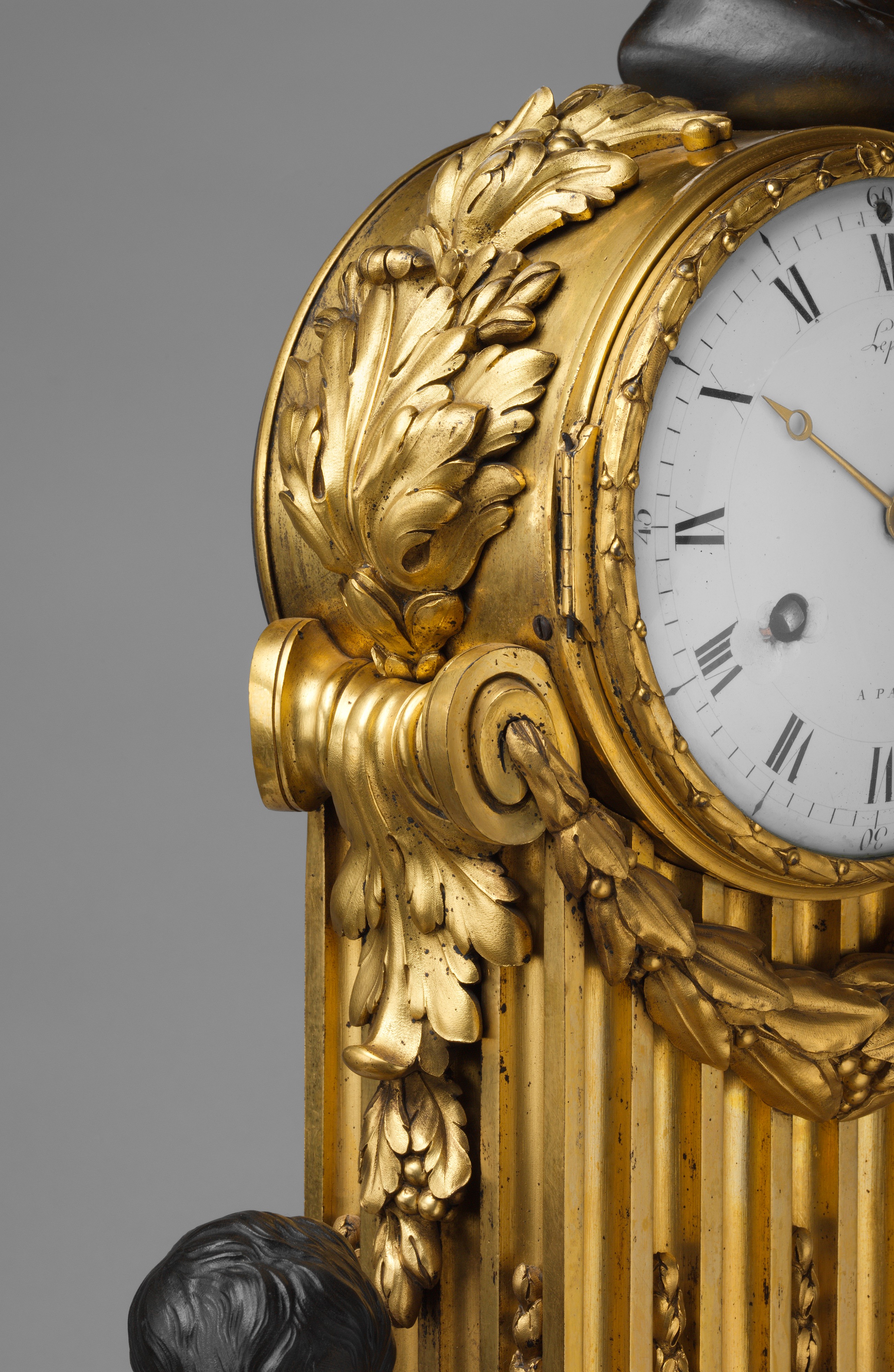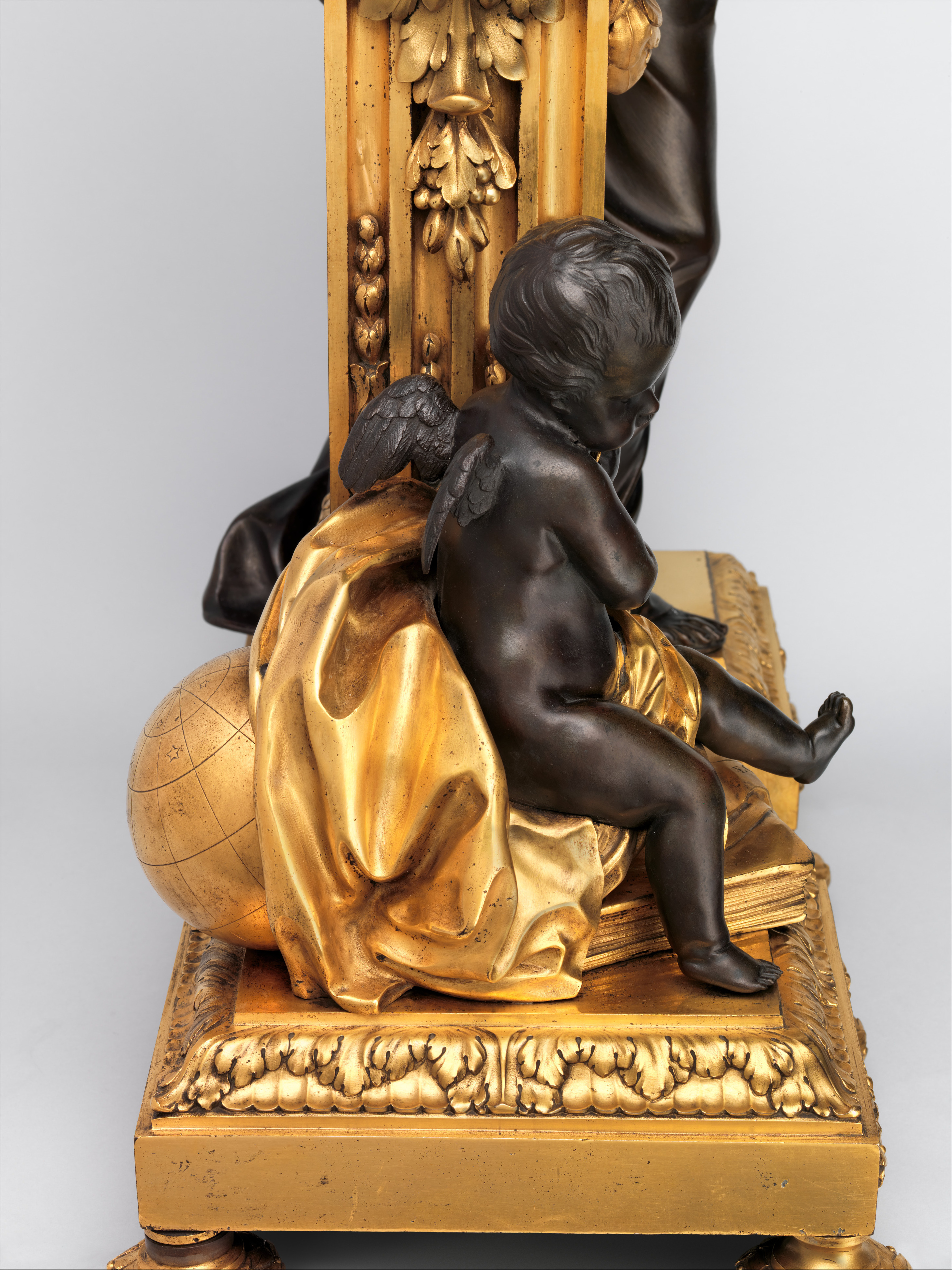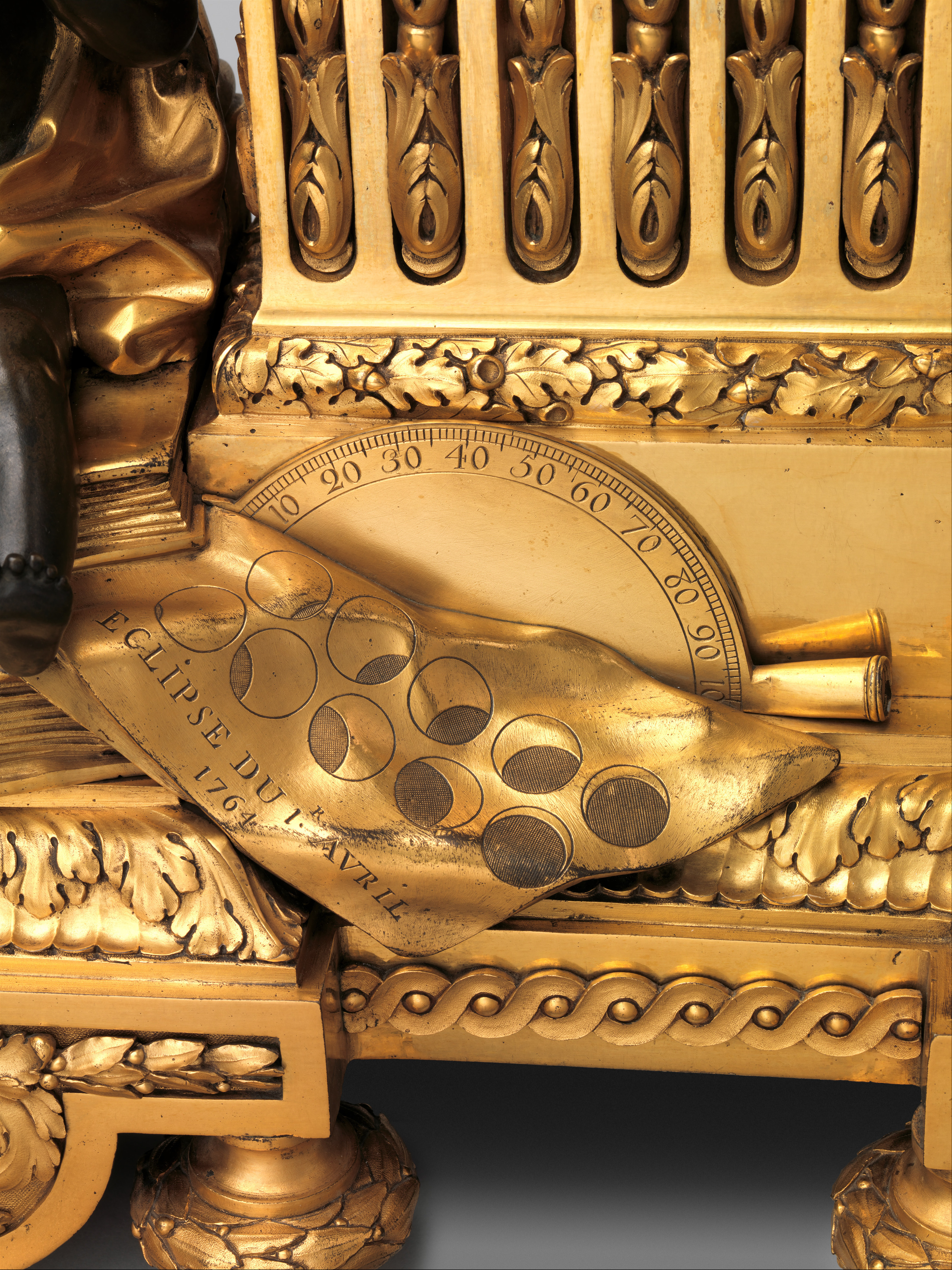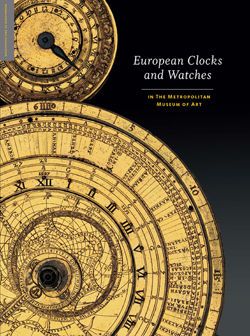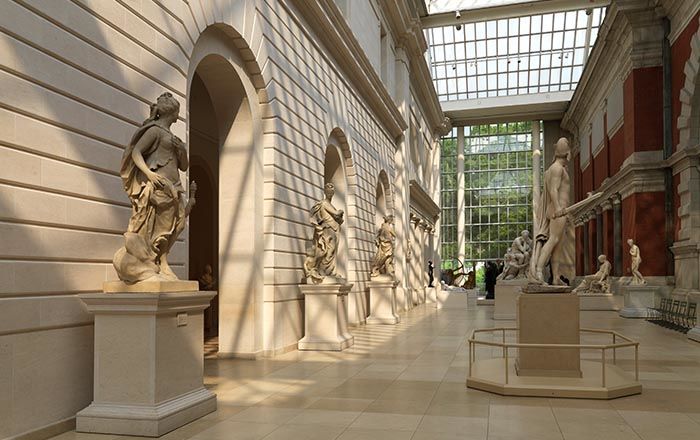Mantel clock ("Pendule Uranie")
Clockmaker: Jean-André Lepaute French
Clockmaker: Jean-Baptiste Lepaute French
Not on view
Time and astronomy are inextricably linked: the daily rotation of the earth and the apparent motion of the sun through the constellations of the zodiac provide the basis for the terrestrial day and the year. The months correspond loosely to the lunar cycle, but the motion of the moon is by no means easily determined. In the price list dated 1766 for the twenty-four clocks that Jean-André Lepaute (1720– 1789) supplied to his clients, titled Description de plusieurs ouvrages d’horlogerie (Description of Several Clock Works), his model number one is described as Pendule Uranie, or a pendulum clock with a figure of Urania, the Muse of Astronomy.[1] In his description, Lepaute claims the figure of Urania is based on a model by the French sculptor Jean-Antoine Houdon (1741–1828).[2] With minor changes in some of the details, the description in the list matches that of a clock in the Metropolitan Museum’s collection.
The case for the Museum’s clock consists of a truncated pilaster made of gilded bronze that rests on a richly ornamented gilded-bronze base and supports a cylindrical movement with a white-enamel dial, the hours (I–XII) and the minutes (15–60, by fifteen- minute intervals) marked in black. The dial is signed, “Lepaute / AParis,” and below the six o’clock position, in tiny script, appears “Dubuis” (presumably the signature of the dial painter). The elegantly slim hour and minute hands are made of gilded brass. A swag of husks is draped below the dial. The figure of Urania, her right hand holding a scroll with the zodiacal symbols for Libra and Scorpio, leans against the movement. She wears a classical Greek dress that is bound at the waist with a contrasting belt with stars, and there is a second belt of undecorated gilded brass in her hair. Opposite Urania, a playful winged cherub, his drapery askew, turns away from the bird that he holds in both hands as he sits on a stack of heavy books. Behind him is a celestial globe, and beside him lies both a chart of a lunar eclipse, labeled “ECLIPSE DU 1.R AVRIL / 1764,” and a semicircle, labeled 10–100, by tens, with a projecting piece of something that might well be a sighting device. All of these elements are created from gilded bronze, and they are probably meant not only as attributes appropriate to an infant Genius of Astronomy[3] but also as allusions to the activities of Madame Jean-André Lepaute (1723–1788), the clockmaker’s wife, who was an able mathematician also known by her maiden name Nicole-Reine Etable de la Brière.
A good theory that would accurately predict the moon’s motion was lacking during the first part of the eighteenth century. Among the mathematicians who proposed solutions was the Frenchman Alexis- Claude Clairaut (1713–1765), whose Theorie de la lune (Theory of the Moon; 1752) won a prize given by the Imperial Academy of Sciences that same year.[4] His publications, as well as more successful ones by his contemporaries Tobias Mayer (1723–1762) and Leonard Euler (1707– 1783), who also attempted solutions to lunar theory, were not only important to theoretical science but also to the very practical problem of finding the longitude.[5] In the same period, the French astronomer Joseph-Jérôme Lalande (1732–1807) became the editor of the French almanac Connaissance des temps (Knowledge of Time), where some of Madame Lepaute’s scientific work appeared. With Lalande, Madame Lepaute helped Clairaut with the laborious calculations leading up to the prediction of the return of Halley’s Comet in 1761.[6] She also assisted Lalande with tracking the transit of Venus, the observation of the path of the planet across the face of the sun in 1769.[7] Her directions for the construction of pendulums appeared in her husband’s treatise on clockmaking, the Traite d’horlogerie (Treatise on Clockmaking; 1755).[8] Her prediction of the lunar eclipse that occurred in 1764 was published in 1762 under her own name,[9] and it is Madame Lepaute’s chart of the eclipse that appears on the base of the Museum’s clock. The clock was destined in all probability for display on a mantelpiece in a Parisian mansion where it could suggest to the participants in a fashionable salon that its owner was cognizant of the importance of astronomy to the science of the period.[10]
The movement attests to the competence of its makers, Jean-André Lepaute and his brother Jean-Baptiste. It is spring driven and consists of two circular brass plates held apart by four pillars, and it includes a going barrel with a train of four wheels regulated by a pinwheel escapement and a pendulum of approximately seventeen inches with spring suspension. The striking train, like the going train with a going barrel and no fusee, has four wheels and a fly, and it is controlled by a count wheel. It strikes hours on a bell that is mounted vertically on the back plate.
The pinwheel escapement, a variety of recoilless escapement, was the French answer to the Englishman George Graham’s (1673–1751) dead-beat escapement and was probably invented about 1740 by the Paris clockmaker Louis Amant (master in 1725; died before 1753). Historians Jean-Nérée Ronfort and Jean-Dominique Augarde believe that Jean-André Lepaute had experimented with a form of dead-beat escapement before coming to Paris, and he probably showed his experiments to Amant when he first arrived.[11] It is not certain what experiments these may have been, but a diagram of the pinwheel escapement appears as the invention of Amant in the 1741 Traite de l’horlogerie by Antoine Thiout l’aîné.[12] In Jean-André Lepaute’s own treatise on clock- and watchmaking, he describes an improved version of the pinwheel escapement of his own invention.[13] In this device a wheel with twenty-four pins—small cylinders attached on one flat side that catch and release two separate arms—mounted on the pendulum arbor, was modified so that the pins are placed alternately on both flat sides of the wheel, which are semicircular in section instead of circular. Lepaute asserted that his escapement was better than both Graham’s and Amant’s, and that it had met the approval of Lalande, member of the Académie Royale des Sciences in Paris [14] and the colleague and mentor of Madame Lepaute. In the succeeding chapter Lepaute gave directions on how to construct his version of the pinwheel. Nevertheless, it is Amant’s original version of the pinwheel escapement that the Lepautes used in the Museum’s clock.
Jean-André Lepaute was without doubt a skillful and inventive clockmaker. Augarde has affirmed that Lepaute was the son of André Lepaute, a locksmith in Thonne-la-Long in the Ardennes region of France from whom Jean-André probably learned metal casting, ironwork, and perhaps a variety of turret clockmaking.[15] When Jean-André arrived in Paris, he had not served the required period of apprenticeship to a Parisian clockmaker and therefore was not eligible for membership in the Paris guild of clockmakers. He seems, however, to have become a protégé of Amant’s. His marriage to Nicole-Reine Etable de la Brière in 1747 [16] brought him contact with both scientists and intellectuals, and his Traite d'horlogerie contains his wife’s mathematical calculations. Among his inventions was a clock with a single wheel that he presented to the French King Louis XV (1710–1774) in 1751.[17] Ronfort and Augarde believe that Jean- André had already been appointed Clockmaker to the King, as evidenced by his occupation of a lodging in the royal palace of Luxembourg,[18] where he was engaged to make a turret clock for the palace. Among other privileges, the appointment usually carried an award of a lodging or workshop within the Galeries du Louvre, but according to Ronfort and Augarde, the award was not granted until 1756, when he was given lodging number fourteen.[19] He retired in 1775 [20] and left the business to his brother Jean-Baptiste, who had joined him in Paris in the 1740s, as well as to two nephews, Pierre-Henry (1748–1806) and Pierre-Basile (1750–1843). Jean-Baptiste had received a royal appointment sometime before 1774 and the occupancy of the fourteenth lodging in the Louvre in 1775.[21] Due to their success, Jean-André and Jean-Baptiste had long outgrown the space in the Louvre; therefore, they had establishments elsewhere in Paris, including the prestigious rue Saint- Honoré in 1766 and the Place du Palais Royal by 1772. [22]
The Museum also has an example of model number two, the Pendule Clio (the Muse of History), from the 1766 price list,[23] as well as four clocks from the period in which the firm consisted of Jean-Baptiste, Pierre-Henry, and Pierre-Basile (17.190.2126).[24] Three clocks have the revolving horizontal dials for which the Lepaute workshop was noted. One of the clocks is housed in an imposing case depicting the Triumph of Love over Time by the French founder Etienne Martincourt (active 1762–1800) [25] with figures cast after models by the French sculptor Augustin Pajou (1730–1809). A number of variants of the case design were made for the Lepautes,[26] and the winged cherubs from the Urania and the Clio clocks appear together on yet another case for a clock with a movement by the Lepautes.[27] The clock is in good condition. Nothing is known of its provenance before it was given to the Metropolitan Museum by Ogden Mills. It was one of five French clocks from the eighteenth century that entered the Museum’s collection either as his gifts or by bequest,[28] including the Pendule Clio.
Notes (For key to shortened references see bibliography in Vincent and Leopold, European Clocks and Watches in the Metropolitan Museum of Art. NY: The Metropolitan Museum of Art, 2015)
[1] Quoted in Tardy 1971–72, vol. 2, p. 378. Some of the details and attributes are variations of those on the Museum’s clock.
[2] There is apparently no confirmation by Houdon scholars of this attribution.
[3] It is so described (Génie de l’Astronomie) in Lepaute’s price list. See Tardy 1971–72, vol. 2, p. 378.
[4] Clairaut 1752.
[5] For a further discussion of the lunar solution to finding longitude, see Chandler 1996.
[6] See Clairaut 1760, in which Madame Lepaute’s contributions were not acknowledged.
[7] Lalande 1762, pp. 206ff.
[8] J.-A. Lepaute 1755, pp. 282–97.
[9] N.-R. Lepaute 1762, p. 8. According to Lalande, her chart was available from the printer Lattre on the rue de la Parcheminerie, Paris. See Lalande 1762, pp. 205–6.
[10] Augarde 1996, p. 74.
[11] Ronfort and Augarde in Wilson et al. 1996, p. 180.
[12] Thiout 1741, vol. 1, p. 112, and pl. 44, fig. 38.
[13] J.-A. Lepaute 1755, pp. 191–93, and pl. xiv.
[14] Ibid., p. 192.
[15] Augarde 1996, p. 351.
[16] Ronfort and Augarde in Wilson et al. 1996, p. 179, give the date of the wedding as Aug. 27, 1747. Their evidence is based on a manuscript written by Gabriel-Joseph Lepaute (1793–1882), “Notice Historique sur la famille Lepaute,” in the possession of Michel Henry-Lepaute (see p. 182, n. 2). Elsewhere the marriage year has been given as 1748 or 1749.
[17] See Tardy 1971–72, vol. 2, p. 378.
[18] Ronfort and Augarde in Wilson et al. 1996, p. 179.
[19] Ibid., pp. 179, 182, n. 5. See also Guiffrey 1873, p. 132.
[20] Augarde 1996, p. 351; Ronfort and Augarde in Wilson et al. 1996, p. 180.
[21] Guiffrey 1873, p. 132. He was succeeded there in 1779.
[22] Tardy 1971–72, vol. 2, p. 378.
[23] Acc. no. 37.160.10. For the price list, see ibid., pp. 378–79.
[24] Acc. nos. 17.190.2126, 29.180.4, 41.41, and 1972.284.16. The Lepaute firm continued to exist in Paris until 1952; see Tardy 1971–72, vol. 2, p. 385. For an extended account of the early Lepautes, see Ronfort and Augarde in Wilson et al. 1996, pp. 179–83.
[25] A discovery of Jean-Dominique Augarde. See Augarde 1996, p. 136.
[26] One example is in a private collection in Paris. See Kjellberg 1997, p. 250, fig. b.
[27] Tardy 1971–72, vol. 2, p. 379, model number four. See Augarde 1996, p. 151, fig. 117; this clock was sold at Sotheby’s, New York, Dec. 7, 1991, no. 10, ill.
[28] Acc. nos. 29.180.3, 29.180.4, 37.160.9, and 37.160.10.
This image cannot be enlarged, viewed at full screen, or downloaded.
This artwork is meant to be viewed from right to left. Scroll left to view more.


